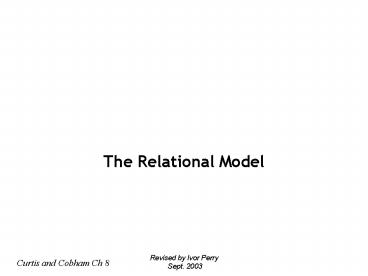Revised by Ivor Perry - PowerPoint PPT Presentation
1 / 17
Title:
Revised by Ivor Perry
Description:
Revised by Ivor Perry. Sept. 2003. Curtis and Cobham Ch 8. The Relational Model ... Revised by Ivor Perry. Sept. 2003. Curtis and Cobham Ch 8. Using a ... – PowerPoint PPT presentation
Number of Views:338
Avg rating:3.0/5.0
Title: Revised by Ivor Perry
1
The Relational Model
2
The Relational Model
- Proposed by Codd in 1970 - Has a mathematical
basis the term relation comes from this - Determining data structure.
- Data is stored in a structure of relations
(tables) defined by a data definition language
(DDL). - The elements of data structure used in relational
models are relations (tables), attributes, tuples
(rows), and domains. - Defining data integrity.
- Data integrity means that data remains stable,
secure, and accurate. - It is maintained by internal constraints known as
integrity rules that are invisible to users.
Curtis Cobham, Business Information Systems,
Prentice Hall Ch8
3
The Data Model
- 3 Components
4
Manipulating Data
- Relations can be manipulated and changed using a
data manipulation language (DML) that employs
relational operators. - These operators are based on the concepts of
relational algebra.
- Information is represented as two dimensional
tables as below.
5
Another Example
Flight
6
Terminology
Flight
Domain set of values drawn upon by a particular
attribute Cardinality No. of Rows in a
relation Degree No. of Columns in a relation
Q Which is most likely to change?
7
Terminology
Flight
8
Terminology
Flight
Table type usually written as follows Flight
(Flight, Origin, Destination, Arrival)
9
Data Manipulation
- Data manipulation is based on relational algebra,
or relational calculus - not based on traversal of hierarchies or networks
- 3 relational algebra operations
- SELECT, PROJECT, JOIN
- SELECT produces a new relation
- consisting of selected rows from an existing
relation - e.g. SELECT Flight WHERE Arrival gt11.00
- PROJECT produces a new relation
- consisting of a number of selected columns from
an existing relation - e.g. PROJECT Flight OVER Flight_, Arrival
10
SELECT
11
PROJECT
12
A New Relation
Tour
13
Data Manipulation
- Data manipulation is based on relational algebra,
or relational calculus - not based on traversal of hierarchies or networks
- 3 relational algebra operations
- SELECT, PROJECT, JOIN
- JOIN produces a new relation from 2 existing
relations joined over a common domain - Take the first row from the first relation
(.e.g.. Flight) and compare the attribute value
with each attribute value in the second relation.
If two values are identical, form a row by
concatenating the first row with the row from the
second relation ( strike out the repeat of the
attribute) - e.g. JOIN FLIGHT and TOUR OVER Flight
14
JOIN
15
Using a relational Database
- SQL
- can be used for stand alone queries or embedded
in programs written in various languages - QBE
- Powerful tool to find data
- uses the concept of examples (e.g. flight,
destination) to find data (e.g. arrivalgt11.00)
16
Advantages
- A clear concept of complex data relations
- Allow powerful data manipulation and query
languages - In table form - a natural representation of
data - Data is accessed by value and conditions so the
database can be accessed from any position
(relation) - Access paths are not seen by the end user
- Representation of the data is entirely logical
17
Disadvantages
- The indexes used in implementation are often
large and require heavy storage overheads - Operational speed of relational database systems
can be slower than hierarchical or network
databases - Note do not assume that, as some have said
(Curtis 3rd edition), this makes them unsuitable
for high volume processing. - (a trade-off between ideal and real-world
conditions)

